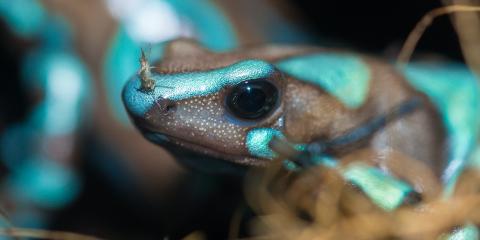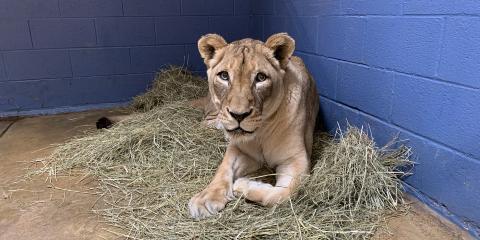Physical Description
Lions have strong, compact bodies and powerful forelegs, teeth and jaws for pulling down and killing prey. Their coats are yellow-gold, and adult males have shaggy manes that range in color from blond to reddish-brown to black. The length and color of a lion's mane is likely determined by age, genetics and hormones. Young lions have light spotting on their coats that disappears as they grow.
Without their coats, lion and tiger bodies are so similar that only experts can tell them apart.
Size
Lions stand between 3.5 and 4 feet (1 and 1.2 meters) tall at the shoulder. Males grow to lengths of 10 feet (3 meters) and have a 2 to 3 foot (60 to 91 centimeter) tail. They weigh from 330 to 550 pounds (150 to 250 kilograms). Slightly smaller, females grow to lengths of 9 feet (2.7 meters) and weigh between 265 and 395 pounds.
Native Habitat
Lions inhabit a wide range of habitats, from open plains to thick brush and dry thorn forest. Except for a small population of the Indian lion subspecies that remains in the Gir Forest of northwest India, lions now live only in Africa, from the Sahara's southern fringe to northern South Africa. They are absent from equatorial areas dominated by moist tropical forest.
Lifespan
Lions in zoos may live into their late teens or early 20s. In the wild, a lioness may live up to 16 years, but males rarely live past the age of 12.
Food/Eating Habits
Lions primarily eat large animals that weigh from 100 to 1,000 pounds (45 to 453 kilograms), such as zebra and wildebeest. In times of shortage, they also catch and eat a variety of smaller animals, from rodents to reptiles. Lions also steal kills from hyenas, leopards and other predators. At times, they may lose their own catches to hyena groups. Lions may also feed on domestic livestock, especially in areas near villages.
The Smithsonian's National Zoo's lions eat ground beef, which is commercially produced to meet the nutritional needs of carnivores. Twice a week, they receive knucklebones or beef femurs, and once a week they receive rabbits, which exercise the cats' teeth and jaws.
Social Structure
Lions are the world's most social felines. They live in groups of related females, called prides, which may comprise several to as many as 40 individuals, including adults, sub-adults (between the ages of 2 and 4) and cubs, plus one or more resident males. Abundance of prey availability plays a significant role in the size of a lion pride. Pride mates associate in sub-groups within the pride.
Females usually stay in their mothers' prides for life, unless food scarcity forces them out. Young males are driven from their prides when they grow large enough to compete with the dominant males (usually between the ages of 2 and 4). They create coalitions, usually with brothers and cousins, and search for a pride to take over. Males entering a new pride will kill all cubs that cannot run from them. Adult males that are fortunate enough to achieve residency within a pride hold tenure for an average of two years, often leaving due to eviction by another coalition of males. In India, female and male lions live apart, joining only to mate.
Males take on most of the defensive duties. However, both males and females mark their territories by roaring — which can be heard up to five miles away — and scent marking with urine. Females raise the cubs and are the primary hunters, although males will sometimes join females during a hunt. Depending on the prey item, several lions may stalk prey from different angles to within 100 feet (30 meters) before attacking the targeted animal. Nomadic males must hunt alone or scavenge from other animals.
Reproduction and Development
Females are receptive to mates for a few days several times a year, unless they are pregnant or nursing, and mating spurs ovulation. They typically give birth to a litter every two years.
Females usually give birth to one to four cubs after a gestation of about 3 1/2 months. Cubs typically nurse for six months but start eating meat at three months. Due to dangers, including starvation during times of food shortage and attacks by male lions taking over prides, up to 80 percent of lion cubs die within their first 2 years of life.
Conservation Efforts
During the past decade, lion populations have declined by about 30 percent. Currently, an estimated 20,000 lions remain in the wild.
More than 10,000 years ago, lions thrived from North and South America to Europe, Africa and Asia. Today, following climatic changes and after centuries of hunting and habitat degradation by people, lions live primarily in scattered habitats across Africa — with the exception of the Gir Forest lions, which live in a national park in northwest India.
Within these areas, lions still face dangers, including habitat loss, poisoning and hunting. Many have died from diseases such as distemper, which is spread by domestic dogs from villages near natural habitat. To prevent lions from becoming as rare as tigers, large expanses of habitat must be carefully protected. In disease-ridden areas, ranging dogs must be kept away from lions or immunized.
Meanwhile, the isolated Gir Forest lions suffer from inbreeding, a limited habitat and frequent conflicts with people. This critically endangered population consists of only about 250 lions. Though slowly growing, this population is threatened by infrastructure development and needs additional reserves to grow.Lions share their habitat with many different animals.
By saving lion habitat, other species are also protected, including hyena, wildebeest, plains zebra and chital.
Help this Species
- Practice ecotourism by being an advocate for the environment when you’re on vacation. During your travels, support, visit or volunteer with organizations that protect wildlife. Shop smart too! Avoid buying products made from animals, which could support poaching and the illegal wildlife trade.
- Share the story of this animal with others. Simply raising awareness about this species can contribute to its overall protection.
Meet the Animals
The Smithsonian's National Zoo is home to four African lions—males Shaka and Jumbe and females Shera and Amahle.
Luke, one of the Zoo's famous residents, died in 2022.



